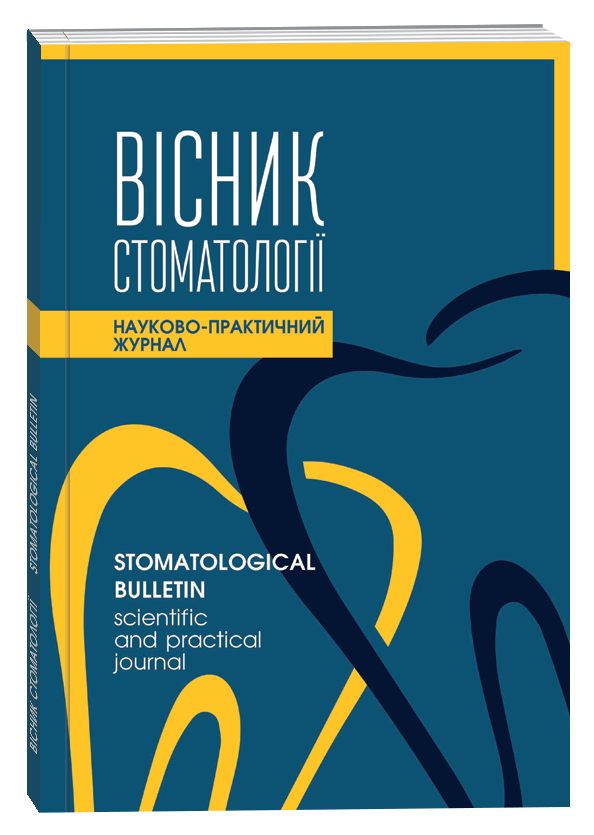INCIDENCE OF DENTAL PATHOLOGY IN PATIENTS AFTER CORONAVIRUS DISEASE
DOI:
https://doi.org/10.35220/2078-8916-2023-50-4.4Keywords:
Covid-19, caries, gingivitis, periodontitis, hyposalivation, tooth demineralization, tooth sensitivity.Abstract
The purpose of this study was to study the frequency of development of dental pathology in patients with Covid-19. Research materials and methods. The studies involved 47 individuals in the age range from 15 years to 51 years: 22 women and 25 men. The mean age of the patients was 36.6±3.5 years. All patients presented the relevant documents about the Covid-19 disease, as well as certified certificates of their recovery. The focus of the studies was to examine the prevalence of the disease at the gender and age level, as well as the severity of the disease, which could further serve as the basis for the adequate implementation of both dental treatment and the prevention of dental diseases in persons after coronavirus disease. Results. It was established that the smallest percentage of patients was in the age group under 20 years old (8.5 %). Most often, faces aged 21-40 years (61.7 %) were sick, of which men. According to the diagnosis by doctors-therapists, a mild degree of Covid-19 was observed in 21.3 % of people, the average severity ‒ in 26 persons (55.3 %), severe form ‒ in 11 (23.4 %), while 9 of them were treated in the hospital. Consequently, the largest percentage of patients experienced mean disease severity. When interviewing patients, it was revealed that carious cavities appeared after the illness. In addition to tooth decay, other symptoms were recorded, namely, the development or exacerbation of gingivitis and periodontitis. The highest rates of caries intensity (14.6±1.8) were observed in patients aged 41-50 years and the lowest in young people under 20 years of age. The prevalence of caries was 100 %, and the inflammatory process in periodontal tissues was 41.9 % and this indicated that almost half of the examined persons needed special treatment. The functional activity of the salivary glands was low, and saliva pH values indicated high acidity. The mineralizing potential of oral fluid, which was studied by the type of saliva crystallization, was reduced. All patients had hypersensitivity of their teeth.
References
World Health Organization. Laboratory testing for coronavirus disease 2019 (COVID-19) in suspected human cases: interim guidance, 2 March 2020. World Health Organization.
Rijsbergen, L.C., van Dijk, L.L.A., Engel, M.F.M., de Vries, R.D., & de Swart, R.L. (2021). In Vitro Modelling of Respiratory Virus Infections in Human Airway Epithelial Cells‒A Systematic Review. Front. Immunol., 12, 683002. doi:10.3389/fimmu.2021.683002.
Zheng, J. (2020). SARS-CoV-2: An Emerging Coronavirus that Causes a Global Threat. Int. J. Biol. Sci.,16, 1678–1685 doi: 10.7150/ijbs.45053.
Sharma Anshika, Farouk Isra Ahmad, & Lal Sunil Kumar. (2021). COVID-19: A Review on the Novel Coronavirus Disease Evolution, Transmission, Detection, Control and Prevention. Viruses. 13(2), 202 doi: 10.3390/v13020202
Dhama Kuldeep, Khan Sharun, Tiwar iRuchi & et al. (2020). Coronavirus Disease 2019–COVID-19. Clin Microbiol Rev. 33(4), e00028-20. doi:10.1128/CMR.00028-20.
Weiming, L., Feng, G., Xia, W., Nianhong, Q., Xianxiong Ch., & et al. (2022). The oral manifestations and related mechanisms of COVID-19 caused by SARSCoV-2 infection. Front Cell Neurosci. 16, 1006977 doi: 10.3389/fncel.2022.
Bordea, I. R., Xhajanka, E., Candrea, S., Bran, S., Onișor F. & et al. (2020). Coronavirus (SARSCoV-2) Pandemic: Future Challenges for Dental Practitioners. Microorganisms, 8(11), 1704 doi: 10.3390/microorganisms8111704.
Zachary, B., & Weintraub, Ja.A. (2020). Oral Health and COVID-19: Increasing the Need for Prevention and Access. Prev Chronic Dis., 17, E82 doi: 10.5888/pcd17.200266.
Drozdzik, A., & Drozdzik, M. (2022). Oral Pathology in COVID-19 and SARS-CoV-2 Infection‒Molecular Aspects. Int J Mol Sci. 23(3), 1431 doi:10.3390/ijms23031431PMCID.
Silness, J., & Löe, H. (1964). Periodontal disease in pregnancy II. Correlation between oral hygiene and periodontal condition. Acta Odontol. Scand., 22,121-135 doi: 10.3109/00016356408993968.
Tamimi, F., Altigani, Sh., & Sanz M. (2022). Periodontitis and coronavirus disease 2019. Periodontol 2000. 89(1), 207–214 doi: 10.1111/prd.12434.
Grigoriadis, A., Räisänen, I.T., Pärnänen, P., Tervahartiala T., Sorsa, T., & Sakellar, D. (2022). Is There a Link between COVID-19 and Periodontal Disease? A Narrative Review. Eur J Dent.16(3), 514–520 doi:10.1055/s-0041-1740223









